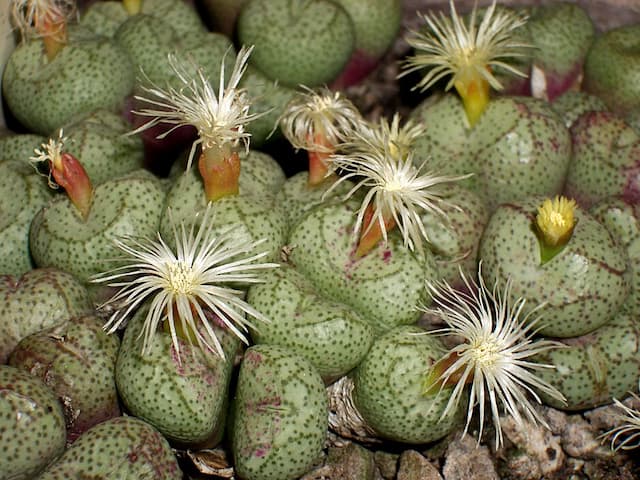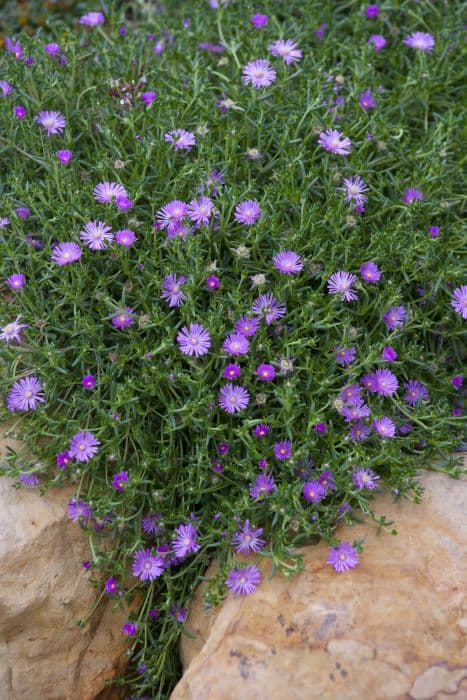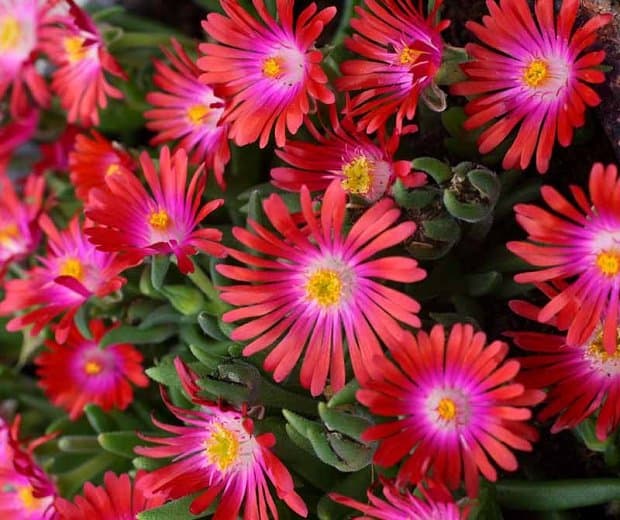White Nugget Malotigena frantiskae-niederlovae 'White Nugget'

ABOUT
Malotigena frantiskae-niederlovae 'White Nugget' is a plant that stands out primarily for its captivating foliage and striking flowers. The 'White Nugget' variety, as suggested by its name, features radiant white blooms that tend to be quite prominent, often contrasting beautifully with the surrounding greenery. These flowers, typically large and showy, serve as the main visual draw for this plant, likely attracting pollinators as well as the admiration of onlookers. The leaves of 'White Nugget' are typically rich and lush, creating a dense backdrop for the bright blossoms. The color of the foliage tends to be a deep green, which not only complements the white flowers but also highlights the overall robustness of the plant. The texture of the leaves can vary, often contributing to the tactile experience when one brushes against them. When not in bloom, 'White Nugget' remains an attractive plant, thanks to its evergreen nature that provides consistent color and texture throughout the year. The overall shape of the plant can range from rounded to slightly spreading, giving it a full and healthy appearance. While it's notable that the specifics regarding the plant's size are excluded from this description, 'White Nugget' is generally appreciated for its visual appeal rather than its dimensions. The harmonious blend of its white flowers and verdant foliage makes it a compelling addition to any garden or landscape where color and vitality are desired. Despite the restrictions, this depiction should give you a sense of the aesthetic qualities of Malotigena frantiskae-niederlovae 'White Nugget', understanding that it's admired for the beauty it brings to gardens, rather than the physical space it occupies.
About this plant
 Names
NamesFamily
Brassicaceae
Synonyms
White Nugget Morisia, White Nugget Hornungia
Common names
Malotigena frantiskae-niederlovae 'White Nugget'.
 Toxicity
ToxicityTo humans
As of my last update, there is no recognized plant by the scientific name "Malotigena frantiskae-niederlovae 'White Nugget'", and therefore no information is available about its toxicity to humans. It may be a fictional, newly discovered, or misidentified species. Please consult with a botanist or poison control center for accurate and up-to-date information on the plant in question.
To pets
As of my last update, there is no recognized plant by the scientific name "Malotigena frantiskae-niederlovae 'White Nugget'", and therefore no information is available about its toxicity to pets. It may be a fictional, newly discovered, or misidentified species. Please consult with a veterinarian or poison control center for accurate and up-to-date information on the plant in question.
 Characteristics
CharacteristicsLife cycle
Perennials
Foliage type
Deciduous
Color of leaves
Varies
Flower color
White
Height
3 feet (0.91 meters)
Spread
2 feet (0.61 meters)
Plant type
Herb
Hardiness zones
Varies
Native area
Unknown
Benefits
 General Benefits
General Benefits- Aesthetic Appeal: The 'White Nugget' plant adds visual interest to gardens and indoor spaces with its unique foliage and growth habit.
- Low Maintenance: Known for its ease of care, this plant doesn't require frequent watering or special soil conditions to thrive.
- Drought Tolerance: Once established, 'White Nugget' is quite tolerant of dry conditions, making it a good choice for water-wise gardens.
- Adaptability: It can adapt to a range of light conditions, from partial shade to full sun, depending on its environment.
- Pest Resistance: This variety of plant is generally resistant to pests and diseases, reducing the need for chemical treatments.
- Long Blooming: The 'White Nugget' has a long blooming period, providing flowers or visual interest for an extended time.
 Medical Properties
Medical PropertiesThis plant is not used for medical purposes.
 Air-purifying Qualities
Air-purifying QualitiesThis plant is not specifically known for air purifying qualities.
 Other Uses
Other Uses- Edible Decoration: The 'White Nugget' can be used as an edible garnish for culinary presentations due to its unique appearance.
- Erosion Control: This plant can be utilized on slopes and banks to help prevent soil erosion thanks to its root system.
- Natural Dyes: The pigments from the 'White Nugget' can be extracted to create natural dyes for fabrics or crafts.
- Photography: Due to its distinctive aesthetic, this plant often serves as a subject for botanical photographers and artists.
- Companion Planting: 'White Nugget' can be planted alongside vegetables to attract beneficial insects and thus promote a healthier garden ecosystem.
- Education: This plant is used in educational settings for studies on plant growth, adaptation, and taxonomy.
- Thematic Gardening: It can be featured in a white-themed garden for visual coordination or to celebrate specific occasions like weddings.
- Sound Barrier: When planted in thick hedges, it helps to reduce noise pollution from roads and industrial areas.
- Urban Landscaping: Used in city parks and green spaces for its ability to thrive in urban conditions while providing aesthetic value.
- Seasonal Celebrations: The 'White Nugget' might be used decoratively during winter festivities due to its snow-like appearance.
Interesting Facts
 Feng Shui
Feng ShuiThe White Nugget is not used in Feng Shui practice.
 Zodiac Sign Compitability
Zodiac Sign CompitabilityThe White Nugget is not used in astrology practice.
 Plant Symbolism
Plant Symbolism- Purity: The 'White Nugget' variety of Malotigena frantiskae-niederlovae, often represents purity due to its pristine white flowers.
- Renewal: As a plant that may bloom or renew itself regularly, it can symbolize the idea of renewal or new beginnings.
- Rarity: This plant, with its unique and uncommon name, is likely to be rare, symbolizing exclusivity or preciousness.
- Delicacy: Because the name suggests a delicate or refined quality, the plant can be associated with attributes of grace and elegance.
 Water
WaterThe White Nugget, commonly known as Snow-on-the-Mountain, requires moderate watering to maintain evenly moist soil. Typically, water once a week by pouring water evenly around the base until the soil is saturated. Depending on temperature and humidity, this may equate to about 1-2 gallons over a month for a potted plant. Adjust the frequency if the top inch of soil dries out sooner or if the plant is in a particularly hot, dry, or windy location. Overwatering can lead to root rot, so ensure good drainage and allow the top layer of soil to dry slightly between waterings.
 Light
LightSnow-on-the-Mountain thrives in bright, indirect light conditions. It should be placed in a location where it receives plenty of light but is shielded from direct midday sun, which can scorch its leaves. An east or west-facing window with filtered sunlight would be an ideal spot for this plant. If grown outdoors, dappled light under a tree canopy or a similar setting would be suitable.
 Temperature
TemperatureThe ideal temperature range for Snow-on-the-Mountain is between 65 to 75 degrees Fahrenheit, making it well-suited for typical indoor conditions. It can tolerate minimum temperatures down to 60 degrees Fahrenheit and maximum temperatures up to 80 degrees Fahrenheit. Extreme temperatures outside of these ranges should be avoided to prevent stress and damage to the plant.
 Pruning
PruningSnow-on-the-Mountain benefits from occasional pruning to shape the plant and encourage bushier growth. Pruning is best done in the spring or early summer, cutting back leggy stems and removing any dead or yellowing leaves. Pruning every few months will keep the plant looking neat and encourage new, healthy growth.
 Cleaning
CleaningAs needed
 Life cycle
Life cycleMalotigena frantiskae-niederlovae 'White Nugget', also known as 'White Nugget', begins its life as a seed, which upon finding suitable conditions, germinates and sprouts. The seedling stage sees the establishment of roots and the sprouting of initial leaves as the plant begins photosynthesis. As the plant matures into the vegetative stage, it develops a more robust root system and fuller foliage, growing in size and strength. The plant then enters the flowering stage, where it produces flowers in the hopes of pollination; in 'White Nugget', these flowers are typically white and may attract a host of pollinators. Following successful pollination, the plant produces fruits or seed pods that contain seeds, ready to disperse for the next generation. Eventually, as the plant reaches the end of its life cycle, it will wilt and decompose, returning nutrients back to the soil and possibly leaving behind seeds that may germinate to begin the cycle anew.
 Propogation
PropogationPropogation time
Spring-Summer
Propogation: For the Malotigena frantiskae-niederlovae 'White Nugget', commonly known as 'White Nugget', the ideal time for propagation is during the spring to early summer when the plant is exhibiting active growth. The most popular method for propagating 'White Nugget' is through stem cuttings. To do this, a healthy stem tip about 4 to 6 inches (approximately 10 to 15 cm) long with at least two pairs of leaves is cut from the parent plant using a sharp, sterile blade. The lower leaves are then removed, and the cut end can be dipped in a rooting hormone powder to encourage root development, though this step is optional. The cutting is then inserted into a pot filled with a well-draining potting mix, ensuring that at least one pair of leaves is above the soil surface. The pot should be placed in indirect sunlight and kept consistently moist, but not waterlogged, until the cutting establishes a strong root system, which usually takes a few weeks. Once rooted, the new 'White Nugget' plant can be gradually acclimated to regular growing conditions and care.






![Ice plant [Fire Spinner]](/_next/image?url=https%3A%2F%2Fplants-admin.emdemapps.com%2Fimages%2Fplants%2F%2Fimages%2F604b54d98722a.png&w=640&q=75)


